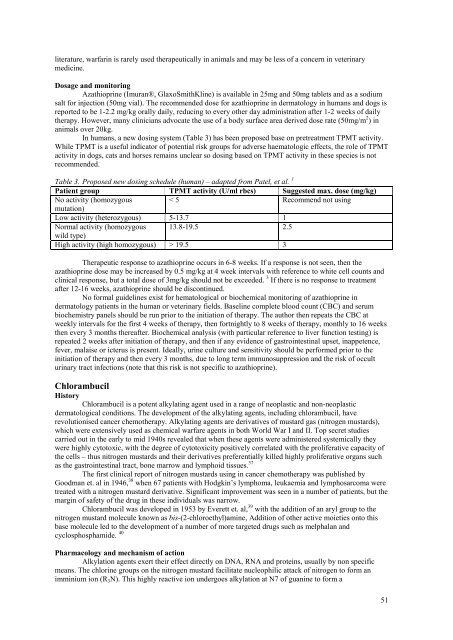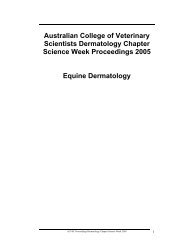Azathioprine and chlorambucil: mechanism of action and use in ...
Azathioprine and chlorambucil: mechanism of action and use in ...
Azathioprine and chlorambucil: mechanism of action and use in ...
Create successful ePaper yourself
Turn your PDF publications into a flip-book with our unique Google optimized e-Paper software.
literature, warfar<strong>in</strong> is rarely <strong>use</strong>d therapeutically <strong>in</strong> animals <strong>and</strong> may be less <strong>of</strong> a concern <strong>in</strong> veter<strong>in</strong>ary<br />
medic<strong>in</strong>e.<br />
Dosage <strong>and</strong> monitor<strong>in</strong>g<br />
<strong>Azathiopr<strong>in</strong>e</strong> (Imuran®, GlaxoSmithKl<strong>in</strong>e) is available <strong>in</strong> 25mg <strong>and</strong> 50mg tablets <strong>and</strong> as a sodium<br />
salt for <strong>in</strong>jection (50mg vial). The recommended dose for azathiopr<strong>in</strong>e <strong>in</strong> dermatology <strong>in</strong> humans <strong>and</strong> dogs is<br />
reported to be 1-2.2 mg/kg orally daily, reduc<strong>in</strong>g to every other day adm<strong>in</strong>istration after 1-2 weeks <strong>of</strong> daily<br />
therapy. However, many cl<strong>in</strong>icians advocate the <strong>use</strong> <strong>of</strong> a body surface area derived dose rate (50mg/m 2 ) <strong>in</strong><br />
animals over 20kg.<br />
In humans, a new dos<strong>in</strong>g system (Table 3) has been proposed base on pretreatment TPMT activity.<br />
While TPMT is a <strong>use</strong>ful <strong>in</strong>dicator <strong>of</strong> potential risk groups for adverse haematologic effects, the role <strong>of</strong> TPMT<br />
activity <strong>in</strong> dogs, cats <strong>and</strong> horses rema<strong>in</strong>s unclear so dos<strong>in</strong>g based on TPMT activity <strong>in</strong> these species is not<br />
recommended.<br />
Table 3. Proposed new dos<strong>in</strong>g schedule (human) – adapted from Patel, et al. 1<br />
Patient group TPMT activity (U/ml rbcs) Suggested max. dose (mg/kg)<br />
No activity (homozygous<br />
mutation)<br />
< 5 Recommend not us<strong>in</strong>g<br />
Low activity (heterozygous) 5-13.7 1<br />
Normal activity (homozygous<br />
wild type)<br />
13.8-19.5 2.5<br />
High activity (high homozygous) > 19.5 3<br />
Therapeutic response to azathiopr<strong>in</strong>e occurs <strong>in</strong> 6-8 weeks. If a response is not seen, then the<br />
azathiopr<strong>in</strong>e dose may be <strong>in</strong>creased by 0.5 mg/kg at 4 week <strong>in</strong>tervals with reference to white cell counts <strong>and</strong><br />
cl<strong>in</strong>ical response, but a total dose <strong>of</strong> 3mg/kg should not be exceeded. 3 If there is no response to treatment<br />
after 12-16 weeks, azathiopr<strong>in</strong>e should be discont<strong>in</strong>ued.<br />
No formal guidel<strong>in</strong>es exist for hematological or biochemical monitor<strong>in</strong>g <strong>of</strong> azathiopr<strong>in</strong>e <strong>in</strong><br />
dermatology patients <strong>in</strong> the human or veter<strong>in</strong>ary fields. Basel<strong>in</strong>e complete blood count (CBC) <strong>and</strong> serum<br />
biochemistry panels should be run prior to the <strong>in</strong>itiation <strong>of</strong> therapy. The author then repeats the CBC at<br />
weekly <strong>in</strong>tervals for the first 4 weeks <strong>of</strong> therapy, then fortnightly to 8 weeks <strong>of</strong> therapy, monthly to 16 weeks<br />
then every 3 months thereafter. Biochemical analysis (with particular reference to liver function test<strong>in</strong>g) is<br />
repeated 2 weeks after <strong>in</strong>itiation <strong>of</strong> therapy, <strong>and</strong> then if any evidence <strong>of</strong> gastro<strong>in</strong>test<strong>in</strong>al upset, <strong>in</strong>appetence,<br />
fever, malaise or icterus is present. Ideally, ur<strong>in</strong>e culture <strong>and</strong> sensitivity should be performed prior to the<br />
<strong>in</strong>itiation <strong>of</strong> therapy <strong>and</strong> then every 3 months, due to long term immunosuppression <strong>and</strong> the risk <strong>of</strong> occult<br />
ur<strong>in</strong>ary tract <strong>in</strong>fections (note that this risk is not specific to azathiopr<strong>in</strong>e).<br />
Chlorambucil<br />
History<br />
Chlorambucil is a potent alkylat<strong>in</strong>g agent <strong>use</strong>d <strong>in</strong> a range <strong>of</strong> neoplastic <strong>and</strong> non-neoplastic<br />
dermatological conditions. The development <strong>of</strong> the alkylat<strong>in</strong>g agents, <strong>in</strong>clud<strong>in</strong>g <strong>chlorambucil</strong>, have<br />
revolutionised cancer chemotherapy. Alkylat<strong>in</strong>g agents are derivatives <strong>of</strong> mustard gas (nitrogen mustards),<br />
which were extensively <strong>use</strong>d as chemical warfare agents <strong>in</strong> both World War I <strong>and</strong> II. Top secret studies<br />
carried out <strong>in</strong> the early to mid 1940s revealed that when these agents were adm<strong>in</strong>istered systemically they<br />
were highly cytotoxic, with the degree <strong>of</strong> cytotoxicity positively correlated with the proliferative capacity <strong>of</strong><br />
the cells – thus nitrogen mustards <strong>and</strong> their derivatives preferentially killed highly proliferative organs such<br />
as the gastro<strong>in</strong>test<strong>in</strong>al tract, bone marrow <strong>and</strong> lymphoid tissues. 37<br />
The first cl<strong>in</strong>ical report <strong>of</strong> nitrogen mustards us<strong>in</strong>g <strong>in</strong> cancer chemotherapy was published by<br />
Goodman et. al <strong>in</strong> 1946, 38 when 67 patients with Hodgk<strong>in</strong>’s lymphoma, leukaemia <strong>and</strong> lymphosarcoma were<br />
treated with a nitrogen mustard derivative. Significant improvement was seen <strong>in</strong> a number <strong>of</strong> patients, but the<br />
marg<strong>in</strong> <strong>of</strong> safety <strong>of</strong> the drug <strong>in</strong> these <strong>in</strong>dividuals was narrow.<br />
Chlorambucil was developed <strong>in</strong> 1953 by Everett et. al, 39 with the addition <strong>of</strong> an aryl group to the<br />
nitrogen mustard molecule known as bis-(2-chloroethyl)am<strong>in</strong>e, Addition <strong>of</strong> other active moieties onto this<br />
base molecule led to the development <strong>of</strong> a number <strong>of</strong> more targeted drugs such as melphalan <strong>and</strong><br />
cyclosphosphamide. 40<br />
Pharmacology <strong>and</strong> <strong>mechanism</strong> <strong>of</strong> <strong>action</strong><br />
Alkylation agents exert their effect directly on DNA, RNA <strong>and</strong> prote<strong>in</strong>s, usually by non specific<br />
means. The chlor<strong>in</strong>e groups on the nitrogen mustard facilitate nucleophilic attack <strong>of</strong> nitrogen to form an<br />
imm<strong>in</strong>ium ion (R3N). This highly reactive ion undergoes alkylation at N7 <strong>of</strong> guan<strong>in</strong>e to form a<br />
51
















